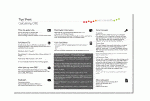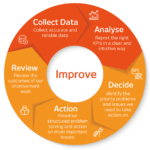Getting KPI Buy-In
Using the phrase `KPI buy-in’ is probably putting it a bit strongly. For many KPI implementations the best you’re looking for initially is the absence of resistance and compliance in terms of gathering information.
Proper buy-in normally only comes after people start to see real value coming from the data. There are a few situations, such as particularly acute, highly visible or painful problems, where it is straightforward to build enthusiasm right from the word go.
We can divide buy-in into five stages:
- Creating engagement.
- Building a case – why you need these measures.
- Removing obstructions.
- Public displays of importance.
- Developing good habits.
Create engagement
- Involve a wide selection of stakeholders in the KPI Tree session. Of all the points on this list this is probably the most effective way of building engagement.
- Go through the reasons behind the new measures clearly and simply with those who are providing the data or are being measured.
- Hold an event, or series of one-to-ones, in which people can frankly and honestly discuss concerns and issues with the proposed measures.
- Deal with potential issues openly and honestly.
- Create a `frequently asked questions’ document for those that could not be involved in the initial engagement process.
Build a case
It’s rational to start by explaining to the team that you need to measure X because if you don’t you are going to `go bust’, `upset customers’ or `get into trouble with the regulators’ etc. Here are the typical steps you would go through to build a `rational’ case:
Build the case for measurement
- Show that there is a real-world benefit from collecting the data. Alternatively, show that there is a significant problem that will arise or become worse if you don’t do this.
- Give relevant and compelling real-life examples of the problems that will be tackled or solved through this approach.
- Explain how you will manage the practicalities of the extra workload created through data collection or analysis.
Whilst this does need to be done, this alone will not build engagement. Engagement is essentially an emotional process and you have just outlined a rational argument.
The best way to build KPI buy-in is to start with emotional engagement followed by a KPI Tree mapping session or stakeholder feedback workshop.
It’s not a straightforward thing, but emotional engagement needs the following in place to work:
- Honesty during dialogue.
- Trust between both parties.
- People to be listened to and feel that they are being listened to.
- Small group (or one-to-one) conversations.
- Relevancy to the needs of the person you are talking to.
A frequent mistake managers make is to react to a lack of engagement by strengthening the rational argument for `the case’. Winning the intellectual argument does not bring people on board emotionally. In fact, steamrollering people with rational argument can often have a completely counter-productive effect.
Remove obstructions
 This is about making life as easy as possible for those that you want to deliver the data or analyses. There is research to show that the easier you make things, the more likely people are to do them
This is about making life as easy as possible for those that you want to deliver the data or analyses. There is research to show that the easier you make things, the more likely people are to do them
-
-
- Create a cheat sheet for each type of user that will be recording or manipulating data.
- Clearly define the process that you want the person or team to follow.
- Test that process with all of the individuals who will be following it, if possible.
-
Create a simple KPI cheat sheet:
-
-
- Making it easy to use
- Step-by-step instructions.
- Decision branches.
- On-screen instructions or screen grabs.
- Identify additional required user skills and where to acquire those skills.
- Contact details for additional help – the more immediate the better. A telephone number is great, having to write a letter is not!
- Make the user guides readily available and easy-to-use.
- Laminated, colour, A3 user-guides work brilliantly.
- Making it easy to use
-
 Make sure the guides are version-controlled and fully up to date. Ensure that changes to the cheat sheets are actioned as fast as humanly possible.
Make sure the guides are version-controlled and fully up to date. Ensure that changes to the cheat sheets are actioned as fast as humanly possible.
Take on board any feedback as quickly as possible – nothing kills the process quicker than lack of interest from its advocates.
Make sure that the line managers of your key data gatherers are fully engaged and are banging the drum for the new system. Any dissent among these people, however subtle, will absolutely destroy your efforts to collect new measures. However tempting it is to bypass middle managers, avoid it at all costs!
Keep people engaged
- Make it easy for people to highlight problems.
- Create a 30-second `any issues session’ in the morning operational meeting, if it exists.
- Add a `comments and improvements’ box on frequently used documentation.
- Spend some time sitting with people as they collect and record any data that you are requesting. (This does a couple of things. It makes it easier for them to highlight problems and also shows that there is a keen interest in the data that is being collected.)
- Let people know quickly about any actions taken as the result of feedback. If you can’t address feedback positively, let people know why.
Public displays of importance
 No, this doesn’t mean having a special KPI hat that teams need to wear. This is about making sure that both the tangible and intangible signals being delivered by senior management are positive and supportive of the KPI process. You need to do your homework beforehand, because discovering that you have no support at this point can be very embarrassing and frustrating.
No, this doesn’t mean having a special KPI hat that teams need to wear. This is about making sure that both the tangible and intangible signals being delivered by senior management are positive and supportive of the KPI process. You need to do your homework beforehand, because discovering that you have no support at this point can be very embarrassing and frustrating.
Test support for the implementation
- Have full and frank discussions with the senior managers right at the start to make sure that they are fully engaged and supportive.
- Document what it is you’re trying to achieve and get them to sign it off (and, yes, I mean physically sign it off).
- Get your senior stakeholders to write a briefing document explaining why this is so important. If you can’t get them to do this (due to the usual `I’m too busy’, `I don’t have my diary’ or `Could you do me a favour and write one for me?’), then you will need to write one for them to sign off. Not ideal but better than nothing.
- Ensure that senior stakeholders kick off any roadshow,frequently asked questions or roll-out briefing sessions. They need to explain:
-
- Why it’s important.
- What will happen if it doesn’t succeed.
- The interest they will show in this.
- When the next follow-up is.
- What they will expect to see in a follow-up.
- Their confidence in the success of this process.
- Let people know there is an open door to discuss any real and practical problems that may come up.
- Make sure that everything the senior stakeholders say in public and private is aligned and supportive of what you’re trying to do.
- Private off-the-record comments are often taken very seriously by subordinates and if you’re hearing whispers that are not aligned to the project objectives you need to address these very seriously and as early as possible.
- Follow-up here is really important so schedule in regular review or `steering’ sessions to keep everybody focused.
-
Developing good habits
Good habits can be really helpful with a new KPI system. Habits take time to form. Once people have got into the habit of gathering and analysing the data that you need, things get a lot easier. In the same way that you barely think about cleaning your teeth in the morning, so people will start to semi-automatically produce and process the information that your KPI system depends upon.
There’s an awful lot of pseudo-science around the number of repetitions required to form a habit. I’m not going to try and come up with the `magic figure’ for habit formation but you will certainly recognise when you reach that stage. When you reach that stage, things get done as part of everyday business, rather than as the result of chasing. There are certain things that you can do to help habit formation – or to really stuff it up.
Make sure data collection stays on track
-
-
- Minimise the amount of process variation between repetitions. Don’t make the process too different each time if you can possibly avoid it.
- Make sure there is a `heartbeat’ i.e. a predictable frequency between repetitions.
- Tackle any instances of `falling out of the habit’ as quickly as possible.
- Fix any problems that stop people doing what they should – and fast!
- Reinforce good work with plenty of positive feedback.
- Track and measure errors and omissions on a visual management chart, if practicable and appropriate.
-
Ways to ‘break’ KPI buy-in..
-
-
- Changing the process frequently or unnecessarily.
- Changing the layout or position of user interfaces, forms or documentation.
- Making the process complex, cumbersome or difficult to adhere to.
- Allowing `grey’ exceptions to exist without clear guidance on procedure. This will only encourage people to park something not completed.
-
The process of gaining buy-in is different every time. There are no guaranteed routes to success. The principles above should put you in the best possible position, but remember that you are dealing with humans – honesty, persistence and regular review are your best tools.







